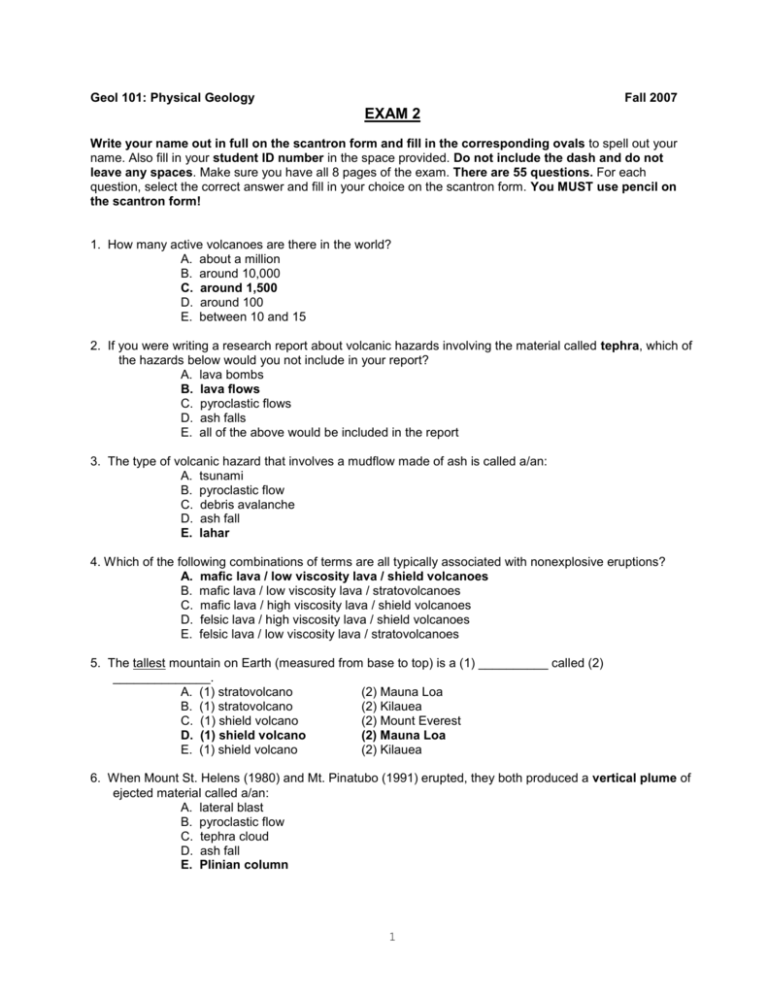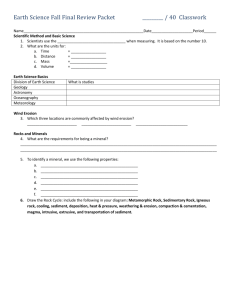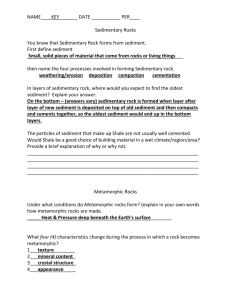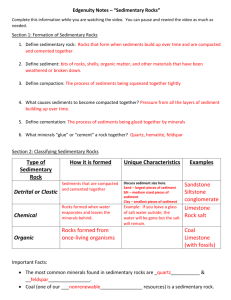Word format
advertisement

Geol 101: Physical Geology Fall 2007 EXAM 2 Write your name out in full on the scantron form and fill in the corresponding ovals to spell out your name. Also fill in your student ID number in the space provided. Do not include the dash and do not leave any spaces. Make sure you have all 8 pages of the exam. There are 55 questions. For each question, select the correct answer and fill in your choice on the scantron form. You MUST use pencil on the scantron form! 1. How many active volcanoes are there in the world? A. about a million B. around 10,000 C. around 1,500 D. around 100 E. between 10 and 15 2. If you were writing a research report about volcanic hazards involving the material called tephra, which of the hazards below would you not include in your report? A. lava bombs B. lava flows C. pyroclastic flows D. ash falls E. all of the above would be included in the report 3. The type of volcanic hazard that involves a mudflow made of ash is called a/an: A. tsunami B. pyroclastic flow C. debris avalanche D. ash fall E. lahar 4. Which of the following combinations of terms are all typically associated with nonexplosive eruptions? A. mafic lava / low viscosity lava / shield volcanoes B. mafic lava / low viscosity lava / stratovolcanoes C. mafic lava / high viscosity lava / shield volcanoes D. felsic lava / high viscosity lava / shield volcanoes E. felsic lava / low viscosity lava / stratovolcanoes 5. The tallest mountain on Earth (measured from base to top) is a (1) __________ called (2) ______________. A. (1) stratovolcano (2) Mauna Loa B. (1) stratovolcano (2) Kilauea C. (1) shield volcano (2) Mount Everest D. (1) shield volcano (2) Mauna Loa E. (1) shield volcano (2) Kilauea 6. When Mount St. Helens (1980) and Mt. Pinatubo (1991) erupted, they both produced a vertical plume of ejected material called a/an: A. lateral blast B. pyroclastic flow C. tephra cloud D. ash fall E. Plinian column 1 7. If a volcano erupts explosively and then collapses into the void left by the emptying of the magma chamber below the mountain, it produces a wide and deep circular hole called a: A. crater B. cinder cone C. lava dome D. caldera E. maar crater 8. An example of the feature described in question 7 is: A. Mount St. Helens B. Crater Lake C. Lassen Peak D. Mauna Loa E. Kilauea 9. The world’s largest lava dome is: A. Lassen Peak, California B. Mount St. Helens, Washington C. Craters of the Moon, Idaho D. Yellowstone, Wyoming E. Mauna Loa, Hawaii 10. Which western US volcano last erupted about 70,000 years ago? A. Mount Mazama B. Mount Rainier C. Mount St. Helens D. Craters of the Moon E. Yellowstone 11. The most active volcano in the Cascades is: A. Lassen Peak B. Mount St. Helens C. Mount Shasta D. Mount Jefferson E. Crater Lake 12. The largest eruption of any Cascades volcano in the past 6800 years was from: A. Mount Mazama B. Mount Tehama C. Mount Diorama D. Mount Banana E. Mount St. Helens 13. Before Mount St. Helens erupted in 1980, the last Cascades volcano to erupt (from 1914-1917) was: A. Crater Lake B. Mount Rainier C. Mount Shasta D. Mount St. Helens E. Lassen Peak 14. Which of the following statements is TRUE regarding the eruption of Mount St. Helens in 1980? A. the volcano erupted unexpectedly and without warning in May of that year B. a huge landslide produced an earthquake that then shook the volcano until it erupted C. a lateral blast occurred first during the eruption, followed by a Plinian column 2 D. because of advance evacuations, no-one was killed during the eruption E. ash from the eruption did not travel more than a few miles from the volcano 15. What is regolith? A. broken down rocks produced by the phenomenon of frost wedging B. the process by which rocks are converted to soil C. fragments of rocks that result from the processes of weathering D. sedimentary particles that were produced by chemical weathering only E. slabs of stone such as those that were used to create Stonehenge 16. Freeze and thaw in rocks is: A. also called frost wedging B. a direct result of water in cracks freezing and expanding by 9% in volume C. a form of mechanical weathering D. responsible for causing blocks of rock to dislodge, forming talus E. all of the above 17. A type of mechanical weathering that involves the process of exhumation is: A. frost wedging B. unloading C. thermal effects D. crystal growth E. biological activity 18. Minerals like halite and calcite are particularly prone to chemical weathering through the process of dissolution. As a result, the following type of rock is prone to this type of weathering: A. limestone B. rock salt C. marble D. all of the above E. none of the above 19. What mineral commonly breaks down into clay when it is chemically weathered? A. quartz B. muscovite C. feldspar D. olivine E. calcite 20. What type of chemical weathering is analogous to rusting, causing the iron in rocks to turn reddish? A. oxidation B. hydrolysis reactions C. dissolution D. acid rain E. exhumation 21. Which of the soil horizons make up topsoil? A. O B. E C. A D. O and A E. E and A 22. An example of a transported soil is: A. loess 3 B. C. D. E. topsoil pedocal pedalfer laterite 23. Sedimentary rocks are the most common type of rock at the Earth’s surface, but they actually only comprise about _______ of the Earth’s crust altogether. A. 5% B. 10% C. 25% D. 50% E. 75% 24. Which of the following terms does NOT relate to the originally horizontal layering of sedimentary strata? A. beds B. bedding C. cross-bedding D. strata E. stratification 25. In sedimentary rock types, the term detrital means the same thing as: A. chemical B. biochemical C. biogenic D. clastic E. lithic 26. If a clastic sedimentary rock contains grains that are about the size of grains of salt, what would the grains be called? A. clay B. silt C. sand D. pebbles E. cobbles 27. Match up the sediment type with the corresponding correct rock name: A. pebbles - conglomerate B. silt - mudstone C. clay - arkose D. boulders - greywacke E. cobbles - sandstone 28. With what type of clastic sedimentary rock would you associate the descriptive term fissile? A. sandstone B. breccia C. mudstone D. siltstone E. shale 29. Which of the following descriptions would be most applicable to a well sorted sediment? A. a sediment deposited by glaciers B. sand blown about by the wind in a desert C. a sediment containing a combination of silt and sand D. a deposit of lake bottom mud made of clay and silt E. a conglomerate with rounded pebbles in a matrix of smaller grain sizes 4 30. What category of sedimentary rocks can form by the evaporation of water and consequent precipitation of minerals like halite? A. gypsum B. detrital C. clastic D. chemical E. biochemical 31. In sedimentary rocks, what is the difference between the terms biochemical and biogenic? A. biochemical sediment is produced when shells dissolve in sea water whereas biogenic sediment is only produced on land when plants die B. biochemical sediment includes the remains of any biological organisms whereas biogenic sediment forms by the dissolution of the mineral apatite to form rocks called phosphorites C. biochemical sediment forms when living things alter the water chemistry, causing minerals to precipitate, whereas biogenic sediment refers to the actual remains of once living organisms D. none of the above describe these two terms correctly 32. Which of the following descriptions is TRUE when talking about graded bedding? A. it typically forms when sediment is transported by the wind B. the sediment in a bed is all about the same size C. large sediment grains are at the bottom and small grains are at the top D. graded beds are never found in the ocean E. graded bedding is particularly useful for figuring out paleocurrent directions 33. If a sedimentary rock contains two beds, with the lower one showing cross-beds inclined downwards towards the west and the upper bed having cross-beds inclined downwards towards the east, then we know that: A. the paleocurrent was originally towards the west and later towards the east B. the paleocurrent was originally towards the east and later towards the west C. the paleocurrent was always towards the west D. the paleocurrent was always towards the east E. the cross-beds must have formed underwater 34. An example of a trace fossil: A. leaf imprint B. fossils of marine organism shells C. fossilized bird bones D. dinosaur footprint E. fossilized wood 35. Which of the following statements regarding lithostatic pressure is correct? A. it is caused by the weight of the overlying rocks B. it is equal in magnitude from all directions C. it causes rocks to decrease in volume but it does not change the rock shape D. all of the above E. none of the above 36. A foliation develops in a metamorphic rock because: A. platy minerals always align with each other during any type of metamorphism B. the original rock that got metamorphosed must have had a foliation in it C. differential stress causes minerals to align parallel to each other D. high temperatures during metamorphism always cause minerals to recrystallize with a foliation 5 E. all metamorphic rocks have a foliation by definition 37. Which of the following terms does NOT refer to a type of foliation in metamorphic rocks? A. gneissic texture B. slaty cleavage C. schistosity D. migmatite E. gneissosity 38. Which of the following metamorphic rocks is most likely to be produced by intermediate-grade metamorphism of shale? A. schist B. greenschist C. quartzite D. slate E. gneiss 39. What type of metamorphism results in the development of an aureole? A. dynamic B. shock C. regional D. contact E. burial 40. If two different types of rocks (e.g., shale and basalt) get metamorphosed at exactly the same temperatures and pressures as each other, then: A. the sequence of index minerals will be identical as the two rocks get metamorphosed B. the mineral assemblages will be identical C. the metamorphic grade will be the same in each case D. the resultant metamorphic rocks will be identical E. one will produce slate and the other will produce granulite 41. On a map of metamorphic rock distributions, the lines on the map that separate regions having different index minerals are called: A. isotherms B. isograds C. isobars D. isochromatics E. isochrons 42. What is meant by the term chronological sequence? A. it is one of the principles of stratigraphy used to determine relative ages B. it refers to the absolute ages of rocks C. it is the geologic time scale that we use to characterize the ages of all rocks D. it is the amount of time that a radioactive substance takes to decay E. it is the order that things happened in geologic history 43. Which principle of stratigraphy essentially tells us that the oldest sedimentary beds are at the bottom and the youngest ones are on top? A. principle of cross-cutting relationships B. principle of stratigraphic superposition C. principle of angular unconformities D. principle of original horizontality E. principle of biostratigraphy 6 44. An unconformity across which the beds are parallel to each other despite a large time break is called a/an: A. disconformity B. angular unconformity C. nonconformity D. oddity E. intrusive contact 45. The correct arrangement of the different types of geologic time divisions, from longest to shortest, is: A. epochs, periods, eras, eons B. periods, eons, epochs, eras C. eons, eras, periods, epochs D. eons, epochs, eras, periods E. eras, periods, epochs, eons 46. Which time period precedes the Ordovician Period? A. Tertiary B. Silurian C. Cretaceous D. Permian E. Cambrian 47. The epoch that we currently live in is called the (1)______ and it began (2)_____ years ago: A. (1) Quaternary (2) 10,000 B. (1) Pleistocene (2) 100,000 C. (1) Tertiary (2) 1 million D. (1) Holocene (2) 10,000 E. (1) Cenozoic (2) 1 million 48. Which of the following statements is true of alpha decay when referring to radioactivity? A. an atom remains unchanged but gives off gamma rays and generates a lot of heat B. an atom releases a proton and a neutron from the nucleus C. an atom releases an electron from the nucleus causing a neutron to turn into a proton D. an atom absorbs an electron into the nucleus causing the atomic number to decrease by 1 E. an atom releases a pair of protons and a pair of neutrons from the nucleus 49. An isotope that undergoes decay starts off as a/an (1) _____ and becomes a (2) _____: A. (1) unstable isotope (2) radioactive isotope B. (1) daughter (2) son C. (1) daughter (2) parent D. (1) parent (2) daughter E. (1) mutant (2) dormant 50. Which of the following statements about radioactive decay is TRUE?: A. decay rates are always affected by the physical and chemical environment B. alpha decay is always followed by beta decay, ending with electron capture C. the amount of daughter isotopes is always decreasing D. one half of the available unstable isotopes always decays during one half-life E. all parent isotopes undergo decay at the same time BONUS QUESTIONS 51. A volcano that has never erupted in historic times but which may still erupt one day is said to be: 7 A. B. C. D. E. active dormant extinct in remission asleep 52. The correct order of soil horizons from the top down is: A. O E A C B B. O A E B C C. O C B A E D. A O E C B E. A B C D E 53. For which of these types of rocks would you attempt to identify the grain size by rubbing the rock gently across your teeth? A. shale B. sandstone C. granite D. siltstone E. conglomerate 54. What type of metamorphism would result from a meteorite impact? A. dynamic B. shock C. regional D. contact E. burial 55. If a certain species is known, based on fossil evidence, to have existed on Earth from the Permian to the Cretaceous Periods, in which of the following aged rocks would we never find fossils of this creature? A. Permian B. Cretaceous C. Jurassic D. Cambrian E. Triassic 8







